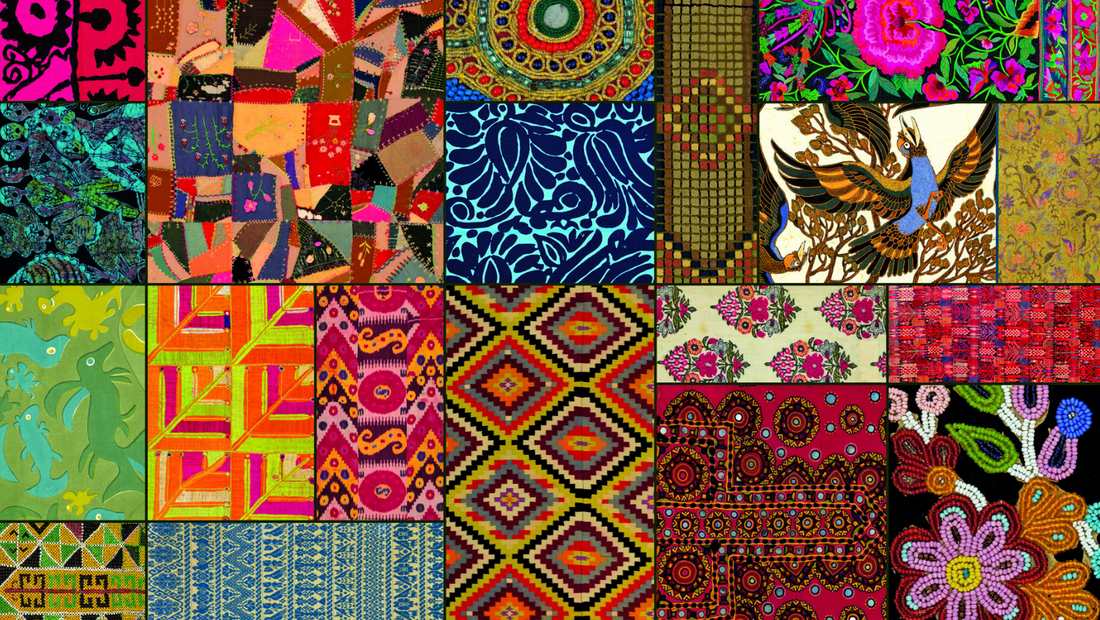
THE TEXTILE MUSEUM OF CANADA OPENS NEW COLLECTION GALLERY
Image courtesy of Textile Museum of Canada
The Textile Museum of Canada opens its new Collection Gallery on 29 March 2023, with the inaugural installation Gathering, featuring community stories told through its global collection. The installation presents over 40 pieces spanning the 18th to 21st century from the Museum’s permanent collection of over 15,000 objects. Choices of objects, responses, and retellings were gathered via open online calls for reflection, through partnerships with local organisations, and through artists’ interventions. Gathering presents collection objects alongside contemporary artistic outputs through four themes – Migration and Diaspora, Everyday Life, Ancestral Reclamation and Artists’ Responses, and Resilience – that explore the human experience through textiles.
Migration and Diaspora is examined through several examples, including an early 20th century embroidered woman’s dress from Pakistan paired with personal stories from community participant Beenish Tahir, and war rugs from Afghanistan presented alongside original videos produced in partnership with the Afghan Women’s Organization (AWO). A colourful quilt tells the story of a family’s journey of sailing from Cromarty, Scotland, to Quebec in 1831. A baby carrier from Thailand with finely stitched reverse appliquéd designs — well-used and repaired — provides a glimpse into the everyday life of the Akha people over 50 years ago. Textiles and their connections to the environment and human resilience are considered through clothing and footwear made from local renewable plant resources, such as an early 20th century mino-boshi or rain hat from Japan, made of rice straw, bark, and seaweed (pictured on right). A rare 19th century kilim from Korea inspired artist Jung-Ah Kim to create a video response retelling the story of the kilim, or modam, through animation.
The narratives and meanings revealed through the voices of individuals featured throughout the installation invite us to consider what artist Carol Ann Apilado referred to as “textile as worldview” – how we build upon stories over time and space, and how each cultural belonging holds multiple layers of relevance.
Among the Museum’s new acquisitions in this initial installation are a 19th century Ainu attush robe from Hokkaido, Japan, and eight contemporary beaded works by Vancouver-based, Anishnabekwe artist Bev Koski. Gathering also features additional contemporary artworks and personal digital responses by Par Nair, Katy Biele, and others.
Community participant and artist Par Nair responded to a saree in the Museum’s collection with her own embroidered textile artworks.  Community participant and artist Par Nair responded to a saree in the Museum’s collectionwith her own embroidered textile artworks. Video still courtesy of the artist
Community participant and artist Par Nair responded to a saree in the Museum’s collectionwith her own embroidered textile artworks. Video still courtesy of the artist
“We are thrilled to open our new Collection Gallery with an installation that highlights the diverse perspectives and artistic responses of the many communities that make up Tkaronto and the country now called Canada,” said Kirsten Kamper, Director and CEO of the Textile Museum of Canada. “Gathering builds on a deep understanding of the evolving nature of collections, their complex histories, and the need for transparency regarding whose voices are represented and how an object came to be in the collection. This installation lays the foundation for continued long-term partnerships and collaborations with the communities we serve.”
“Developing this exhibition was a collaborative effort from beginning to end,” said Roxane Shaughnessy, Senior Curator and Manager of Collection at the Museum. “Working alongside Museum team members and curatorial advisor Devyani Saltzman, we identified themes and narratives that emerged through community participation that highlight the significance textiles have for all of us and the rich stories they hold.”
Occupying the majority of the Museum's second floor, the new Collection Gallery is built on an existing history of acquisitions, largely based on individual donations, dating back to the Museum’s founding in 1975. Informed by the Museum’s newly refreshed collection development plan, its mandate includes a renewed dedication to installations and rotations rooted in the voices and stories of local and national communities.
Rotations of work on display will occur twice yearly with the long-term goal for the Collection Gallery to be an ever-evolving space programmed in response to the times.
Find out more:
textilemuseum.ca
@textilemuseumofcanada
